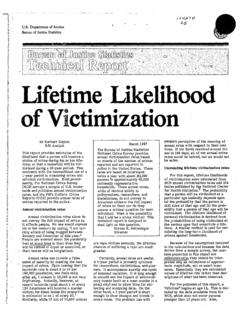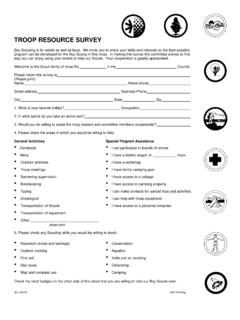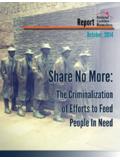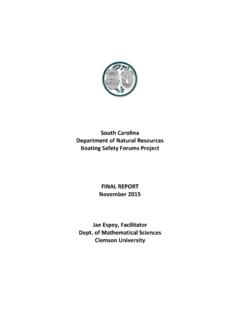Transcription of Indicators of School Crime and Safety: 2016
1 Indicators of School Crime and safety : 2016 NCES 2017-064 NCJ DEPARTMENT OF DEPARTMENT OF JUSTICE OFFICE OF JUSTICE PROGRAMSI ndicators of School Crime and safety : 2016 MAY 2017 Lauren Musu-GilletteProject OfficerNational Center for Education StatisticsAnlan ZhangKe WangJizhi ZhangAmerican Institutes for ResearchBarbara A. OudekerkBureau of Justice Statistics NCES 2017-064 NCJ DEPARTMENT OF DEPARTMENT OF JUSTICE OFFICE OF JUSTICE Department of EducationBetsy DeVosSecretaryInstitute of Education SciencesThomas W. Brock Commissioner for Education ResearchDelegated the Duties of the DirectorNational Center for Education StatisticsPeggy G. CarrActing CommissionerThe National Center for Education Statistics (NCES) is the primary federal entity for collecting, analyzing, and reporting data related to education in the United States and other nations.
2 It fulfills a congressional mandate to collect, collate, analyze, and report full and complete statistics on the condition of education in the United States; conduct and publish reports and specialized analyses of the meaning and significance of such statistics; assist state and local education agencies in improving their statistical systems; and review and report on education activities in foreign countries. The Bureau of Justice Statistics (BJS) is the primary federal entity for collecting, analyzing, publishing, and disseminating statistical information about Crime , its perpetrators and victims, and the operation of the justice system at all levels of government. It fulfills a congressional mandate to provide valid statistics on Crime and justice systems, support improvement to justice information systems, and participate with national and international organizations to develop and recommend national standards for justice statistics.
3 We strive to make our products available in a variety of formats and in language that is appropriate to a variety of audiences. You, as our customer, are the best judge of our success in communicating information effectively. If you have any comments or suggestions about this product, we would like to hear from you. Please direct your comments toNCES, IES, Department of Education Potomac Center Plaza 550 12th Street SW Washington, DC 20202 Bureau of Justice StatisticsJeri M. MulrowActing DirectorMay 2017 This report was prepared for the National Center for Education Statistics under Contract No. ED-IES-12-D-0002 with American Institutes for Research. Mention of trade names, commercial products, or organizations does not imply endorsement by the CitationMusu-Gillette, L.
4 , Zhang, A., Wang, K., Zhang, J., and Oudekerk, (2017). Indicators of School Crime and safety : 2016 (NCES 2017-064/NCJ 250650). National Center for Education Statistics, Department of Education, and Bureau of Justice Statistics, Office of Justice Programs, Department of Justice. Washington, DC. This publication is only available online. To download, view, and print the report as a PDF file, go to or Contact at NCESL auren at BJSB arbara A. Executive SummaryIntroductionOur nation s schools should be safe havens for teaching and learning, free of Crime and violence. Any instance of Crime or violence at School not only affects the individuals involved, but also may disrupt the educational process and affect bystanders, the School itself, and the surrounding community (Brookmeyer, Fanti, and Henrich 2006; Goldstein, Young, and Boyd 2008).
5 Establishing reliable Indicators of the current state of School Crime and safety across the nation and regularly updating and monitoring these Indicators are important in ensuring the safety of our nation s students. This is the aim of Indicators of School Crime and safety . This report is the 19th in a series of annual publications produced jointly by the National Center for Education Statistics (NCES), Institute of Education Sciences (IES), in the Department of Education, and the Bureau of Justice Statistics (BJS) in the Department of Justice. This report presents the most recent data available on School Crime and student safety . The Indicators in this report are based on information drawn from a variety of data sources, including national surveys of students, teachers, principals, and postsecondary institutions.
6 Sources include results from the School -Associated Violent Death Surveillance System, sponsored by the Department of Education, the Department of Justice, and the Centers for Disease Control and Prevention (CDC); the National Crime Victimization Survey and School Crime Supplement to that survey, sponsored by BJS and NCES, respectively; the Youth Risk Behavior Survey, sponsored by the CDC; the Schools and Staffing Survey, School Survey on Crime and safety , Fast Response Survey System, EDFacts, and Early Childhood Longitudinal Study, Kindergarten Class of 2010 11, all sponsored by NCES; the Supplementary Homicide Reports, sponsored by the Federal Bureau of Investigation; the Campus safety and Security Survey and Civil Rights Data Collection, both sponsored by the Department of Education; and the Trends in International Mathematics and Science Study, sponsored by the International Association for the Evaluation of Educational Achievement.
7 The most recent data collection for each indicator varied by survey, from 2009 to 2015. Each data source has an independent sample design, data collection method, and questionnaire design, or is the result of a universe data collection. Findings described in this report with comparative language ( , higher, lower, increase, and decrease) are statistically significant at the .05 level. Additional information about methodology and the datasets analyzed in this report may be found in appendix A. This report covers topics such as victimization, teacher injury, bullying and cyber-bullying, School conditions, fights, weapons, availability and student use of drugs and alcohol, student perceptions of personal safety at School , and criminal incidents at postsecondary institutions.
8 Indicators of Crime and safety are compared across different population subgroups and over time. Data on crimes that occur away from School are offered as a point of comparison where FindingsPreliminary data show that there were 48 School -associated violent deaths1 from July 1, 2013, through June 30, 2014 ( indicator 1). In 2015, among students ages 12 18, there were about 841,100 nonfatal victimizations (theft2 and violent victimization3) at school4 and 545,100 nonfatal victimizations away from School ( indicator 2). In 2015, about 21 percent of students ages 12 18 reported being bullied at School during the School year ( indicator 11). Of the 804 total hate crimes5 reported on college campuses in 2014, the most common type of hate Crime was intimidation (343 incidents), followed by destruction, damage, and vandalism (327 incidents) and simple assault (61 incidents; indicator 23).
9 1 A School -associated violent death is defined as a homicide, suicide, or legal intervention death (involving a law enforcement officer), in which the fatal injury occurred on the campus of a functioning elementary or secondary School in the United States, while the victim was on the way to or from regular sessions at School , or while the victim was attending or traveling to or from an official School -sponsored event. Victims include students, staff members, and others who are not students or staff Theft includes attempted and completed purse-snatching, completed pickpocketing, and all attempted and completed thefts, with the exception of motor vehicle thefts. Theft does not include robbery, which involves the threat or use of force and is classified as a violent Violent victimization includes serious violent crimes and simple At School includes inside the School building, on School property, and on the way to or from A hate Crime is a criminal offense that is motivated, in whole or in part, by the perpetrator s bias against the victim(s) based on their race, ethnicity, religion, sexual orientation, gender, gender identity, or of School Crime and safety : 2016 iiiExecutive SummaryivThe following key findings are drawn from each section of the report.
10 Spotlights xIn 2015, about 15 percent of fourth-graders and 7 percent of eighth-graders reported experiencing bullying at least once a month. These percentages were lower than the international averages for fourth-graders and eighth-graders (16 percent and 8 percent, respectively; Spotlight 1). xIn the United States, 7 percent of participatingfourth-grade students attended schools that were less than safe and orderly, according to the data reported by their teachers. This was higher than the international average of 4 percent as well as higher than the percentages in 22 countries and not measurably different from the percentages in 19 countries. About 13 percent of participating eighth-grade students reported attending schools that were less than safe and orderly, according to the data reported by their teachers; this was higher than the international average of 8 percent.














